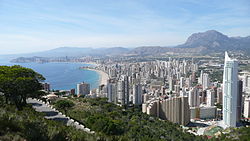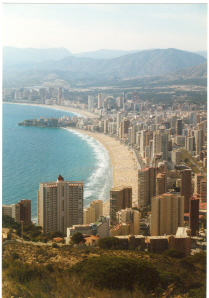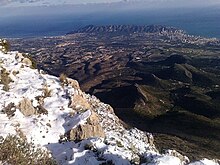Benidorm
Benidorm | |
|---|---|
 View over Benidorm, Costa Blanca | |
| Nickname: "Beniyork" "Beni" | |
| Country | |
| Autonomous community | |
| Province | Alicante |
| Comarca | Marina Baixa |
| Judicial district | Benidorm |
| Government | |
| • Alcalde | Agustín Navarro (2009) (PSPV) |
| Area | |
| • Total | 38.51 km2 (14.87 sq mi) |
| Elevation | 15 m (49 ft) |
| Population (2010) | |
| • Total | 71,198 |
| • Density | 1,800/km2 (4,800/sq mi) |
| Demonym(s) | Sp.: Benidormense Cat.: Benidormer/a |
| Time zone | UTC+1 (CET) |
| • Summer (DST) | UTC+2 (CEST) |
| Postal code | 03501-03503 |
| Official language(s) | Valencian, Spanish |
| Website | Official website |
| 4465v;;087tys | |
Benidorm (/[invalid input: 'icon']ˈbɛnɪdɔːrm/; Catalan pronunciation: [beniˈðɔɾm], Spanish: [beniˈðor]) is a coastal town and municipality located in the comarca of Marina Baixa, in the province of Alicante, Valencian community, Spain, by the Western Mediterranean.
Prior to the 1960s, Benidorm was a small village. Today it stands out for its hotel industry, beaches and skyscrapers, built as a result of its tourist-orientated economy. According to the 2010 census, Benidorm has a permanent population of 71,198 inhabitants, ranking as the fifth most populous town in the Alicante province. It has a population density of 1,848.8 inhab/km². Due to the unique skyline formed by its numerous tall hotels and apartment buildings, which is unlike any other on the Costa Blanca (White Coast) Urban Age project, Benidorm has the most high-rise buildings per capita in the world.[1] Benidorm itself is dwarfed by the 1406 m tall Puig Campana.
History
It is believed there were settlements in the Benidorm area perhaps as far back as 3000BC including evidence of Roman and Punic remains. However, settlements in the area were small and it was not until the Moors (from whom the town derived its Arabic origin name) arrived that the local population began to grow. The Christian King James I of Aragon re-conquered the region in 1245 and Benidorm first officially became known in 1325 when Admiral Bernat De Serria of Polop awarded it a town charter as a way of removing the Moors and allowing Christians to inhabit the area. Benidorm’s history for the next few centuries was plagued by attacks from the sea by Turkish and Barbary pirates. The 17th century saw things improve for Benidorm and its people, most notably with the construction of an advanced irrigation system in 1666 to channel water to the region. By the 18th century Benidorm fishermen had become famous and sought after all over Spain and beyond. Tuna was their main catch and they perfected the ancient almadraba technique passed down from the Arabs. The success of the fishing industry, together with improved local agriculture, helped to fuel a strong local economy. Coastal traffic increased too, bringing more wealth to the region with the town becoming a base for sea captains and the building of their vessels. In 1952 Benidorm’s fishing industry went into decline; a factor in encouraging the town council to approve many new development plans aimed at the tourist market. Today the town is Europe and Spain’s biggest holiday resort and responsible for a significant chunk of Spain’s large tourist industry, with five million tourist arrivals per year.[2]
Local politics
After giving the Spanish Socialist Workers' Party majorities or pluralities in elections from the restoration of democracy in 1977, Benidorm has favoured the right wing People's Party (PP) since the general elections of 1993.[3] The PP gained control of the local council at the 1995 local elections and won 14 of the 25 council seats in the 1999 and 2003 elections. The 2007 election gave them a one seat majority over the PSOE,[4] but disagreements in the PP group led to a motion of censure being passed against the PP mayor in September 2009. He was replaced by the socialist Agustín Navarro.[5]
As of the 2011, local elections, the political composition on the local council was the following:
| Party[6] | Seats | |
|---|---|---|
| PSOE | 11 | |
| PP | 11 | |
| Liberal Democratic Centre | 3 | |
Geography
The town is divided into five parts, Poniente (Ponent) and Levante (Llevant), each fronted by a beach of the same name, the old town (also called El Castell), La Cala situated to the west side of Poniente and El Rincón de Loix or El Racó de l'Oix situated to the east side of Levante. Between the two beaches lies a rocky promontory and the port. The old city occupies the promontory and the area immediately inland, while most of the hotels occupy the more recently developed sections inland from the two beaches. A few miles from shore is an uninhabited island which provides a dramatic centrepiece to the seascape.
In 1954 Pedro Zaragoza Orts, the then young Mayor of Benidorm, created the Plan General de Ordenación (city building plan) that ensured, via a complex construction formula, every building would have an area of ‘leisure’ land, guaranteeing a future free of the excesses of cramped construction seen in other areas of Spain. It is the only city in Spain that still adheres to this rigid rule. Most of the streets in the city are named after places such as Avenida De Uruguay, Avenida Del Mediterráneo, Calle Pekin etc. Avenida Del Mediterráneo is a wide avenue that crosses Levante and links the old town with Rincón. Avenida Europa crosses Levante at right angles linking the western city limits with the Levante beach. Climb to the top of the Serra Gelada, the promontory at the end of the Rincon de Loix, for a view of how green the city is and just how close it is to the mountains.
Benidorm is connected to the FEVE/FGV railway line between Alicante (Alacant) and Denia. The section to Alicante is now converted to tram operation and trams run at least every half an hour between Benidorm and Alicante. Trains run (now hourly) from Benidorm to Denia (vía Altea and Calpe) in connection with the trams.
Climate
Benidorm has a special micro-climate all year round thanks to the mountains which surround the town. It enjoys some 3,400 hours of sunshine a year and an average annual temperature on the coast of 18°C (15°C in winter and 26°C in summer). Between December and March the temperature of the sea water is around 15°C.[7]
| Climate data for Benidorm | |||||||||||||
|---|---|---|---|---|---|---|---|---|---|---|---|---|---|
| Month | Jan | Feb | Mar | Apr | May | Jun | Jul | Aug | Sep | Oct | Nov | Dec | Year |
| Mean daily maximum °C (°F) | 15 (59) |
16 (61) |
18 (64) |
19 (66) |
22 (72) |
26 (79) |
29 (84) |
30 (86) |
28 (82) |
23 (73) |
19 (66) |
16 (61) |
23 (73) |
| Mean daily minimum °C (°F) | 6 (43) |
6 (43) |
7 (45) |
9 (48) |
12 (54) |
16 (61) |
19 (66) |
20 (68) |
17 (63) |
14 (57) |
10 (50) |
7 (45) |
13 (55) |
| Average precipitation mm (inches) | 31 (1.2) |
39 (1.5) |
48 (1.9) |
43 (1.7) |
54 (2.1) |
37 (1.5) |
27 (1.1) |
49 (1.9) |
76 (3.0) |
86 (3.4) |
52 (2.0) |
45 (1.8) |
587 (23.1) |
| Source: holiday-weather.com | |||||||||||||
Tourism

Benidorm is popular with tourists from the UK, Ireland, Germany, Belgium and the Netherlands. Benidorm's initial growth in popularity can be attributed to the package holiday explosion, and continues year round, due to the night-life based around the central concentration of bars and clubs. The large number of free cabaret acts that start around 21:00 and continue into the early hours set Benidorm apart from other similar cities.


The author and Guardian journalist Giles Tremlett identified the city as the birthplace of package tourism in the book Ghosts of Spain: Travels Through a Country's Hidden Past and remarked that culturally the city contradicted conservative notions of National Catholicism that General Franco had espoused.[8] The accessibility of Benidorm to a wider social strata was also detailed in 1990 by the columnist Jani Allan describing in the Sunday Times "These days you just have to look at the numbers of wide-bodied jets bearing wide-bodied holidaymakers to Benidorm to realise that package holidays and airborne cattle trucks make fun in the sun accessible to everyone."[9] In the 1980s Benidorm developed a reputation for British drunken lager louts and violent binge drinking. This did not happen all year round but mainly in the summer months of July and August.[10] During the 1980s families were put off visiting the city. However today the problem of drunkenness and lager louts has largely gone and Benidorm has become more mellowed. Many such people tend to visit other places like Ibiza or Malia. Now there is a very good police presence in the town which has greatly improved safety and provided for a good atmosphere. Nightlife is very popular and mainly involves cabaret acts and Tapas bars. The town is now very popular with families. Also, more and more elderly people from Northern Europe decide to stay here during the winter. This made 'Benidorm' into something of a synonym for elderly people in those countries, as can be seen in the Flemish candid camera programme Benidorm Bastards (due to appear in the US as Betty White's Off Their Rockers)[11]
Benidorm has three major beaches: Playa de Levante (val. Platja de Llevant), Playa de Poniente (val. Platja de Ponent) and Platja del Mal Pas; all of them have a blue flag since 1987, the maximum quality standard recognized by the European Union. The Gran Hotel Bali, a four-star hotel located in this city since 2002, is a 186-metre-tall building which stood as the tallest skyscraper in Spain for five years, until it was surpassed by the CTBA towers in Madrid, it is however the tallest hotel in Europe.
Events and attractions
Each summer, since 1959 to 2000, the city celebrated the Benidorm International Song Festival, a song contest where international or Spanish celebrities like Julio Iglesias, Raphael or the Dúo Dinámico became famous.
Since 2010, in July, Benidorm celebrates an Indie Music festival, with national and international music groups, called "Benidorm Low Cost Festival".
In 2011, Benidorm hosted the start of the Vuelta a España, one of cyclings three grand tours. Benidorm boasts four family-oriented theme parks: Terra Mítica and Terra Natura are inland from the city, at the foot of the mountain and Aqualandia and Mundomar are located on the outskirts of the city on the Llevant side. In addition to large shopping and commercial areas. An Episode of the hit sitcom Only Fools and Horses was filmed in Benidorm. The episode was called It Never Rains....
Also a humorous TV series called Benidorm has aired on ITV (with replays on ITV2) in the UK. Actors include Jake Canuso, Steve Pemberton, Sheila Reid and comedian Johnny Vegas. It finished airing its fifth series on Friday 6 April 2012.
-
Early morning exercise (organised by the local council)
-
Late morning community singing, in Spanish (organised by the local council)
-
Exercise equipment for senior citizens
-
Benidorm Island viewed from a beach of the city
Demographics
Ethnicity
Benidorm is one of the most international towns in Europe and has a high immigrant population. The population in 2010 was 71,198. These figures are for those registered as formal residents and not long-term visitors.[12]
| Country | Spain | Britain | Romania | Ecuador | Argentina | Colombia | Morocco | Bulgaria | China | Pakistan |
|---|---|---|---|---|---|---|---|---|---|---|
| Population | 46,346 | 5,235 | 2,828 | 1,367 | 1,316 | 1,178 | 1,136 | 1,066 | 820 | 779 |
| Percentage | 65.2% | 7.4% | 4.0% | 1.9% | 1.9% | 1.7% | 1.6% | 1.5% | 1.2% | 1.1% |
Population growth
| Year | 1857 | 1887 | 1910 | 1930 | 1950 | 1960 | 1970 | 1981 | 1991 | 1996 | 2001 | 2005 | 2010 |
|---|---|---|---|---|---|---|---|---|---|---|---|---|---|
| Population | 3,720 | 3,183 | 3,498 | 3,113 | 2,726 | 6,259 | 12,124 | 25,544 | 42,442 | 50,044 | 51,873 | 67,492 | 71,198 |
See also
References
- ^ Burdett, Ricky & Sudjic, Deyan. The Endless City. Phaidon Press Ltd. Mar 1, 2008.
- ^ History of Benidorm
- ^ election results in Benidorm
- ^ 2007 local election
- ^ Las Provincias 22 September 2009
- ^ http://elecciones.mir.es/resultados2011/99MU/DMU1703903199_L1.htm?d=756&e=0
- ^ Benidorm weather
- ^ Tremlett, Giles (2006). Ghosts of Spain: Travels Through a Country's Hidden Past. Faber and Faber.
- ^ Allan, Jani. British determination to acquire a suntan; Is this the end of burning ambition? Sunday Times, 6 May 1990
- ^ Clerks Travels 3rd ed 2007
- ^ De Standaard Online - De Zweedse 'sexy bitch' en andere Benidorm Bastards Template:Nl
- ^ Instituto Nacional de Estadistica,
External links
 Benidorm travel guide from Wikivoyage
Benidorm travel guide from Wikivoyage






